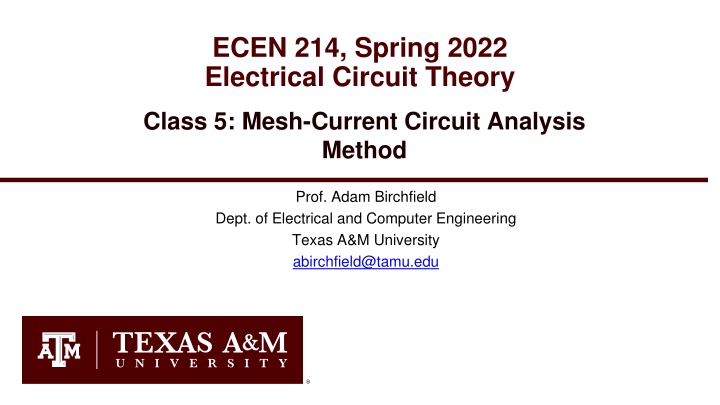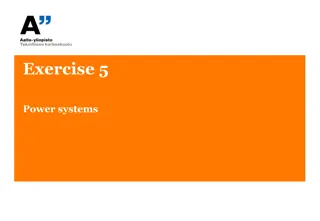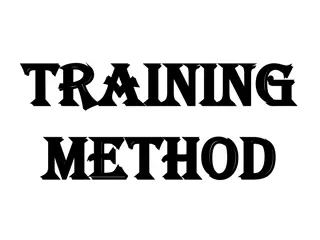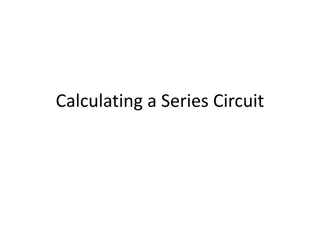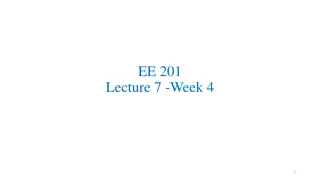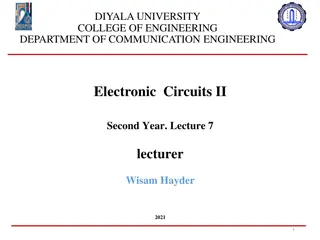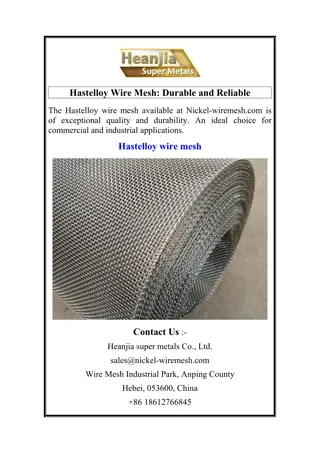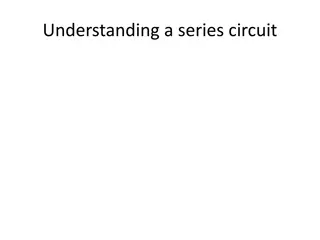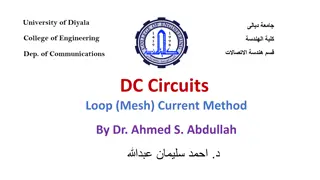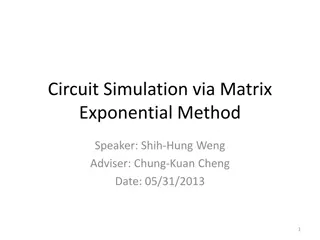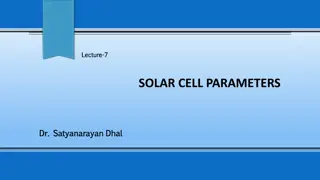Mesh-Current Circuit Analysis Method
In electrical circuit theory, the mesh-current method is a systematic technique used to find voltages and currents in circuits with multiple elements. This method involves identifying loops, assigning mesh currents, applying Kirchhoff's voltage law, and solving for unknowns. Through step-by-step examples, you can learn how to analyze complex circuits efficiently using mesh currents.
Download Presentation

Please find below an Image/Link to download the presentation.
The content on the website is provided AS IS for your information and personal use only. It may not be sold, licensed, or shared on other websites without obtaining consent from the author.If you encounter any issues during the download, it is possible that the publisher has removed the file from their server.
You are allowed to download the files provided on this website for personal or commercial use, subject to the condition that they are used lawfully. All files are the property of their respective owners.
The content on the website is provided AS IS for your information and personal use only. It may not be sold, licensed, or shared on other websites without obtaining consent from the author.
E N D
Presentation Transcript
ECEN 214, Spring 2022 Electrical Circuit Theory Class 5: Mesh-Current Circuit Analysis Method Prof. Adam Birchfield Dept. of Electrical and Computer Engineering Texas A&M University abirchfield@tamu.edu
2 Solving Larger Circuits When we attempt to analyze circuits involving several elements, the number of equations and corresponding unknowns we have to solve for can quickly get out of hand. Last class we looked at the Node-Voltage method for solving large circuits. In this section we will present a second systematic techniques for finding voltages and currents in circuits, the mesh-current method.
3 Mesh-Current Circuit Analysis Method Here are the steps: Step 1 Identify all meshes (loops that do not enclose any other loops) and label a mesh current for each loop. Step 2 Identify voltages across all resistors in each mesh and write in terms of mesh currents. Step 3 Use KVL to write an equation for each mesh. Step 4 Solve for unknowns Step 5 Write actual currents through various elements in terms of mesh currents.
4 Example 1 4 2 6 8 6 + _ + _ 20V 40V
5 Example 1, Step 1 4 2 6 8 6 + _ + _ 20V 40V ?1 ?2 ?3 Step 1 Identify all meshes (loops that do not enclose any other loops) and label a mesh current for each loop. Notes: Mesh currents are not necessarily actual currents that you can measure anywhere in the circuit. You can make your mesh currents go clockwise or counterclockwise, or some CW and others CCW. It doesn t matter.
6 Example 1, Step 2 4 2 6 + ??_ + ??_ + ??_ 8 6 + ?? _ + ??_ + _ ?3 + _ ?2 ?1 20V 40V ??= 2(?1) ??= 6(?2) ??= 4(?3) ??= 8(?1 ?2) ??= 6(?2 ?3) Step 2 - Identify voltages across all resistors in each mesh and write in terms of mesh currents.
7 Example 1, Step 3 4 2 6 + ??_ + ??_ + ??_ 8 6 + ?? _ + ??_ + _ ?3 + _ ?2 ?1 20V 40V Loop 1: 40 = ??+ ?? 40 = 2?1+ 8(?1 ?2) ?1 ?2 ?3 10 8 0 8 20 6 0 6 40 0 20 Loop 2: ??= ??+ ?? 8 ?1 ?2 = 6?2+ 6 ?2 ?3 = 0 = 10 Loop 3: ??= ??+ 20 6 ?2 ?3 = 4?3+ 20 = 0 Step 3 Use KVLs to write an equation for each mesh.
8 Example 1, Step 4 4 2 6 + ??_ + ??_ + ??_ 8 6 + ?? _ + ??_ + _ ?3 + _ ?2 ?1 20V 40V ?1 ?2 ?3 10 8 0 8 20 6 0 6 40 0 20 ?1= 5.6, ?2= 2, ?3= 0.8 = 10 Step 4 Solve for unknowns
9 Example 1, Step 5 4 6 2 + ??_ + ??_ + ??_ ?8 ?6 8 6 + ?? _ + ??_ + _ ?3 + _ ?2 ?1 20V 40V ?8= ?1 ?2= 5.6 2 = 3.6? ?1= 5.6?, ?2= 2?, ?3= 0.8? ?6= ?2 ?3= 2 0.8 = 2.8? Step 5 Write actual currents through various elements in terms of mesh currents.
10 Example 2 Use the mesh-current method to find the power dissipated in the 2 resistor. 3 8 + _ 5 30V 2 16A 6 4
11 Super-meshes supermesh ?1 ?2 ?? For circuits where a current source falls in a mesh where we need to use KVL, we can run into problems since the voltage across the current source may not be known. We can use a supermesh to avoid needing to know the voltage across a current source. Within the supermesh: ??= ?2 ?1 Around the supermesh: Do KVL
12 Example 3 Find the power dissipated in the 1 resistor. 2 2 2A + _ 6V 10V 2 + _ 1
13 Superposition For a circuit with multiple independent sources, we can find the response of the circuit by summing the responses to each individual source. Example: Find ? in the circuit shown 4A 2 5 + ? _ + _ 110V 12 10 Solution: first solve with just the current source, then with just the voltage source.
14 Just the Voltage Source (Assume Current = 0) First find the response of the circuit to the 110V source (remove the current source). 4A 5 2 5 + ?1 _ + ? _ + _ + _ 110V 5.833 110V 12 10 5.833 5 + 5.833= 59.23 ? = 110
15 Just the Current Source (Assume Voltage = 0) Next find the response of the circuit to the 4A source alone (remove the voltage source). 4A 4A ?2 _ ?2 + 2 2 5 3.33 + ? _ + _ 110V 12 10 12 12 ?2= 4 12 + 2 + 3.33= 2.7692 ?2= 2.7692 3.33 = 9.23
16 Solving with Superposition Finally, the desired voltage in the original circuit is just the sum of the voltages found in the two simplified circuits (with only one independent source present). ? = ?1+ ?2= 59.23 9.23 = 50 ? Note 1: When using superposition, we must keep any dependent sources in place. Note 2: Superposition allows us to analyze a complicated circuit by analyzing several simpler circuits. Often, it is easier to just analyze the single (more complicated) circuit rather than trying to analyze multiple circuits. So before using superposition, be sure it is really going to make your life easier. Often it does not. Note 3: The real power of the superposition technique often comes in design type problems as shown in the next slide.
17 Applying Superposition to Circuit Design Suppose in the circuit from the previous example, we were asked to find the value of the current source so that the voltage across the 10 resistor is 40V. The concept of superposition allows us to easily do this. Input Output, V ?? 110V 4A 59.23V -9.23V ? 110? + ?(4?) ? 59.23 + ?( 9.23) 2 5 + Since we are only adjusting the current source, we will use ? = 1 (leave the voltage source alone). Then we want: 59.23 9.23? = 40 ? = 2.0834 + _ 110V 12 10 40V _ Therefore, we should replace the 4A current source with a 2.0834(4A) = 8.33A current source.
18 Assignments Get the Zybook and complete sections 3.6, 3.8, 3.10 Due 4pm on Monday, Feb 7 If you haven t done the earlier sections that were due today, do these as well Homework #2 on Canvas Also due 4pm on Monday, Feb 7 Take it as many times as needed, your best score will count. It is different each time, so it is good for additional practice. Review in-class examples and notes Practice, practice, practice! Don t forget, you need to go to office hours once in either January or February and again in either March or April. Bring at least one technical question! Quiz #5 on Monday
